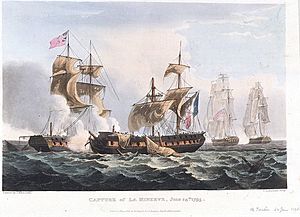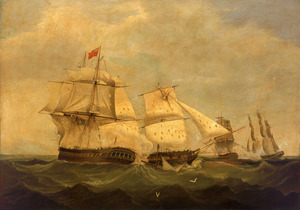Action of 24 June 1795 facts for kids
Quick facts for kids Action of 24 June 1795 |
|||||||
|---|---|---|---|---|---|---|---|
| Part of the French Revolutionary Wars | |||||||
 Capture of La Minerve off Toulon, 24 June 1795, Thomas Whitcombe |
|||||||
|
|||||||
| Belligerents | |||||||
| Commanders and leaders | |||||||
| Strength | |||||||
| 2 frigates | 2 frigates | ||||||
| Casualties and losses | |||||||
| 24 killed and wounded | 30 killed and wounded 1 frigate captured |
||||||
The Action of 24 June 1795 was a small but important naval battle. It took place in the Mediterranean Sea during the French Revolutionary Wars. This was a time when Britain and France were fighting for control of the seas.
In 1795, the British and French navies were trying to be the strongest in the Mediterranean. The French fleet operated from Toulon, a strong port. The British used Port Mahon in Menorca, which was an allied Spanish base. A battle in March, called the Battle of Genoa, didn't completely decide who was stronger. Both sides had ships damaged. The British, led by Admiral William Hotham, went to Menorca for more ships. The French, led by Admiral Pierre Martin, also got more ships. By June, both fleets were ready to fight again.
To find out where the enemy was, both admirals sent out small groups of frigates. Frigates are fast, medium-sized warships. Admiral Hotham sent HMS Dido and HMS Lowestoffe. Admiral Martin sent the larger Minerve and Artémise. On June 24, these scouting groups met. They were almost exactly halfway between the two main naval bases. At first, the French ships sailed away. But when they saw how much smaller the British ships were, they turned around and attacked.
How the Battle Began
In the summer of 1795, the French Revolutionary Wars were being fought at sea. The British and French navies had large fleets in the Mediterranean. The French fleet, based in Toulon, had been damaged earlier. It took almost a year to fix their ships. The British fleet, led by Vice-Admiral William Hotham, tried to blockade Toulon. This meant they tried to stop ships from entering or leaving the port. The British used Port Mahon on Menorca as their main base.
In February 1795, the French fleet was ready to fight again. They sailed to attack Corsica. Under Admiral Pierre Martin, they captured a British ship, HMS Berwick. But then, Hotham's fleet defeated them at the Battle of Genoa in March. The French lost two ships and went back to their coast. After this battle, a storm hit the British fleet. One ship, HMS Illustrious, was wrecked. Hotham gathered his ships and sailed to Menorca. There, he met more British ships from the Channel Fleet. Meanwhile, Martin also got more ships for his fleet. After some delays, Martin's fleet sailed again on June 7.
Both admirals really needed to know where the other fleet was. So, they each sent out two frigates to scout. Hotham sent the smaller 28-gun HMS Dido (led by Captain George Henry Towry) and the 32-gun HMS Lowestoffe (led by Captain Robert Gambier Middleton). Their job was to check Toulon. Martin sent the larger 40-gun Minerve (led by Captain Jean-Baptiste Perrée) and the 36-gun Artémise (led by Captain Charbonnier). Their job was to look for Hotham's fleet near Menorca.
The Fight at Sea
At 4:00 AM on June 24, the two groups of frigates saw each other. They were almost exactly in the middle of Menorca and Toulon. Dido, the first British ship, sent coded signals to the French. The French didn't answer, which showed they were enemy ships. As the British ships moved closer, the French ships turned away and quickly pulled ahead.
However, by 8:00 AM, the weather cleared. The French could see how small the British ships were. So, the French squadron turned around and headed straight for Dido and Lowestoffe. At 8:30 AM, Minerve was close enough to Dido to fire a broadside. A broadside is when a ship fires all the cannons on one side at once. Captain Towry of Dido waited to fire back until Minerve was even closer. By 8:45 AM, he had moved his ship into a good position. He fired at Minerve from a very short distance.
Captain Perrée of Minerve saw the smaller British ship right in front of him. He ordered his ship to go full speed ahead. He tried to ram Dido in the middle. If this had worked, Dido would likely have been crushed by the much larger Minerve. But Captain Towry quickly turned his ship. He turned the wheel hard to the left, moving Dido away from the crash.
The ships were so close that Minerve's bowsprit got caught in Dido's rigging. The bowsprit is a large pole sticking out from the front of a ship. The rigging is the ropes and chains that support the masts. This pulled Dido hard against the side of Minerve. Dido was lifted almost out of the water, hanging from Minerve's bowsprit. French sailors tried to climb along the bowsprit to board Dido and fight hand-to-hand. But British sailors used pikes to stop them. The waves made Dido crash against Minerve again and again. Around 9:00 AM, the bowsprit finally broke. At least eight French sailors fell into the water between the ships. Dido's rear mast also broke and fell.
As the crews worked to free their ships, Minerve and Dido scraped past each other. Their cannons fired again at very close range. Minerve was taller, which gave it an advantage. Its higher spars ripped Dido's top sails off. This allowed Minerve to pull away from the damaged British ship. At this point, Lowestoffe finally arrived. It had been blocked by Dido before. Now, Lowestoffe came up next to Minerve's front and opened fire.
In less than eight minutes, Lowestoffe's raking fire caused huge damage. Raking fire means shooting along the length of the enemy ship, causing a lot of destruction. Minerve's front mast and two top masts crashed down. This made Minerve unable to move. While this was happening, Artémise had sailed by at a distance. It fired its cannons, but it didn't do much. When Captain Charbonnier of Artémise saw that Minerve was badly damaged, he turned his ship and sailed away.
Captain Towry told Captain Middleton of Lowestoffe to chase Artémise. Lowestoffe stopped fighting Minerve at 9:15 AM and went after Artémise. Artémise fired its stern-chasers (cannons at the back) at Lowestoffe, damaging its rear mast. Lowestoffe fired back, but it didn't do much. Artémise was faster and soon got away. At 10:30 AM, the chase was given up. Middleton returned to the damaged and alone Minerve.
Even though he was alone, Captain Perrée of Minerve had not given up. He had not struck his colours (lowered his flag to show surrender). But Middleton was able to bring Lowestoffe close to Minerve's back and start firing again. At 11:45 AM, with its rear mast destroyed and Dido slowly getting closer, the French captain knew he had to give up. He called out to Middleton that he surrendered. Artémise was still far away, but it didn't try to help.
The British had few casualties. Six sailors were killed and 13 wounded on Dido. Three sailors were wounded on Lowestoffe. The exact number of French casualties on Minerve isn't known. But it's thought to be about 30 killed and wounded. This includes those who fell from the bowsprit. Artémise had very few, if any, casualties.
Ships in the Battle
This table shows the ships that fought in the battle. "Guns" means all the cannons on the ship. "Casualties" means the number of people killed or wounded.
| Ship | Commander | Navy | Guns | Tons (bm) |
Broadside weight |
Complement | Casualties | ||
|---|---|---|---|---|---|---|---|---|---|
| Killed | Wounded | Total | |||||||
| HMS Dido | Captain George Henry Towry | 32 | 595 | 156 pounds (71 kg) | 193 | 6 | 13 | 19 | |
| HMS Lowestoffe | Captain Robert Gambier Middleton | 36 | 717 | 210 pounds (95 kg) | 212 | 0 | 3 | 3 | |
| Minerve | Captain Jean-Baptiste Perrée | 42 | 1102 | 370 pounds (170 kg) | 318 | c.30 | |||
| Artémise | Captain Charbonnier | 40 | 600 | 283 pounds (128 kg) | c.300 | negligible | |||
What Happened Next
The damage to Dido's masts meant it couldn't continue its mission. It had to go back to Port Mahon with the captured Minerve. From prisoners, the British learned that the main French fleet had sailed from Toulon. As soon as the ships reached port on June 27, Captain Towry sent a small ship, HMS Fox, to tell Admiral Hotham. Hotham was anchored near Corsica.
Hotham then sent Captain Horatio Nelson to look for the French fleet. Nelson sailed with his ship, HMS Agamemnon, and a small group of ships. On July 7, he found Martin's fleet. Agamemnon went back to Hotham's fleet with the French ships following. On July 8, Hotham sailed to meet them. On July 13, the Battle of the Hyères Islands took place. The British won a small victory, sinking one French ship. Martin then went back to Toulon. The main French fleet did not leave Toulon again that year.
A British historian named William James called this battle "a gallantly fought action" by the British. He said Captain Towry's decision to attack Minerve with Dido was "noble." He pointed out that Minerve was almost twice the size of Dido. It also had over 120 more crew members. James also thought that if Artémise had fought properly, Dido would have been captured. When Captain Charbonnier returned to Toulon, he faced a court-martial. This is a military trial. He was tried for not supporting Captain Perrée, but he was found not guilty.
Minerve was repaired at Port Mahon and then Ajaccio. It was then made part of the Royal Navy. It kept the same name, Minerve, and Captain Towry was put in command. Minerve remained an active warship for the British. However, it was recaptured by the French in another battle on July 2, 1803. After the battle, the first officers of both British ships were promoted to commander. More than 50 years later, the Admiralty recognized the battle. They awarded special clasps, "DIDO 24 JUNE 1795" and "LOWESTOFFE 24 JUNE 1795," to the Naval General Service Medal. This medal was given to any British sailors who were still alive in 1847 and had fought in the battle.


